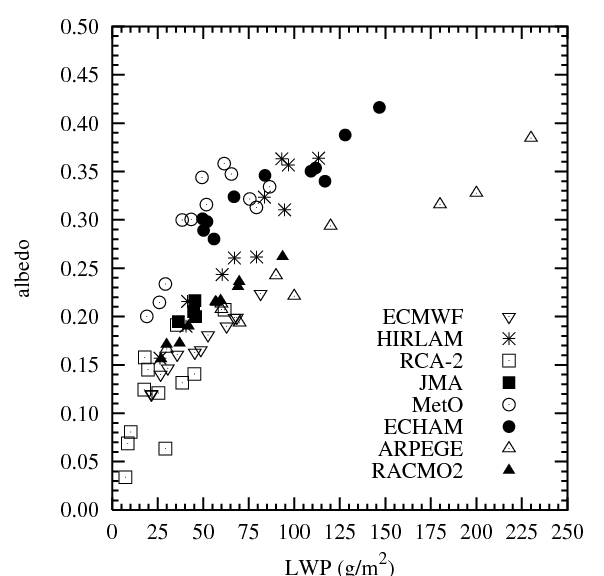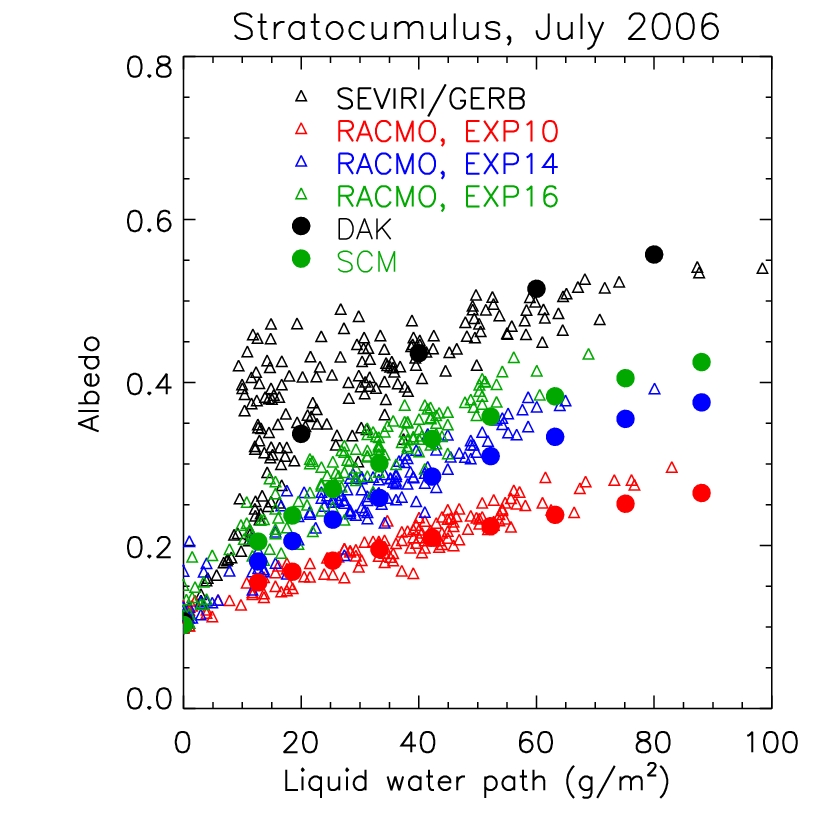EUCLIPSE radiation intercomparison study for stratocumulus
Introduction and motivation
The radiation budget of the Earth is strongly influenced by clouds with a main contribution coming from marine boundary layer clouds such as stratocumulus clouds. At the same time the representation of stratocumulus clouds in climate models is still a challenge due to the complex and subtle interaction between radiation, turbulence and condensational processes. As a result the representation of these clouds in climate models are a major source of uncertainty.
But even if climate models would represent the stratocumulus clouds correctly, it is unclear how well radiation schemes operating in these climate models are capable of retrieving the correct radiative properties for these clouds. In fact scatter plots of liquid water path (LWP) versus top of the atmosphere albedo for subtropical marine stratocumulus for a wide range of climate and numerical weather prediction models show a large spread (see Figure 1 [Siebesma et al. 2004]). Since the LWP determines to first order the albedo, this large scatter suggests large differences between the various radiation schemes that are operational in these models. This observation is one of the motivations to have a more detailed intercomparison of radiation codes for stratocumulus topped boundary layers.

Figure 1: scatter plot of the top of the atmosphere albedo as a function of the LWP for model grid points in the North Pacific region with stratocumulus [Siebesma et al. 2004].
Another motivation is displayed in Figure 2 (courtesy of Wouter Greuell) in which a strong disagreement between satellite observations ([Harries et al. 2005] and [Roebeling et al. 2006]) and a state of art radiation code such as used in the regional atmospheric climate model (RACMO) is found [Greuell et al. 2011]. It displays LWP versus albedo for stratocumulus clouds around local noon as observed off the coast west of Africa in the Southern Atlantic Ocean. The results show that:
- RACMO underestimates the albedo by a factor of 2 in its operational setting;
- lowering the effective radius, r
e, to as low as 5.5 μm and assuming no inhomogeneity still leads to an underestimation of the albedo; - sophisticated radiative transfer models such as the Doubling Adding KNMI (DAK) [Wang et al. 2011], gives albedo values close to observations.
If the atmospheric profiles are idealized and the same calculations are done in a Single Column Model (SCM) framework (dots in Figure 2) similar results are found. These idealized profiles form the basis for this radiation intercomparison study.

Figure 2: scatter plot of albedo at the top of the atmosphere against liquid water path: black triangles are satellite observations (albedo from GERB and liquid water path from SEVIRI),
black dots are Doubling Adding KNMI (DAK) radiative transfer model results,
colored triangles are RACMO results and colored dots are RACMO single column model results,
more precisely operational set-up of cycle 31r1 physics experiment in red,
prescribed effective radius (re = 5.5 μm) experiment in blue and
prescribed re as in the previous experiment and inhomogeneity factor equal to 1 in green.
Scientific questions
The questions that we would like to answer in the present intercomparison study are:
- How large is the spread in albedo calculated by the different radiation codes for the marine stratocumulus topped boundary layer?
- Do more sophisticated radiation codes provide albedos closer to the observations?
- How critical are the assumptions on the internal microphysics for the radiative properties of stratocumulus clouds?
- How sensitive are radiation codes for the used vertical resolution?
Though this intercomparison was initially motivated for radiation codes such as used in climate and numerical weather prediction models, we also cordially invite radiation codes that are used in Large Eddy Simulation (LES) models to participate, as well as more sophisticated stand alone radiation codes (such as DAK) that could serve as a reference.
The main novelty of the present intercomparison study compared to previous ones (e.g. [Oreopoulos et al. 2010]) is that in the present case we specifically focus on the radiative properties of stratocumulus clouds. Addressing the questions spelled out above can be useful for checking the realism of the radiation codes that are used in operational climate models.
Schedule
Simulation results should be emailed to Sara Dal Gesso before 31 March 2011.
For any problems, questions, suggestions, please contact Sara Dal Gesso.
Documentation
All the necessary informations for running the intercomparison study are collected in the NetCDF file radiationtest_input.nc.
Acknowledgements